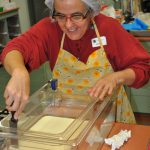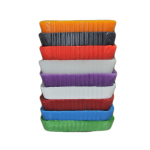When cheese is first hooped it is very moist and needs to be left out overnight and ideally above 20c. This overnight draining is important to allow the lactic acid bacteria to finish fermenting the residual lactose in the cheese which in turn removes the residual moisture from the curd. Any ripening cultures added to the milk will also continue their established and growth in this phase.
When cheese is first hooped it is very moist and needs to be left out overnight and ideally above 20c. This overnight draining is important to allow the lactic acid bacteria to finish fermenting the residual lactose in the cheese which in turn removes the residual moisture from the curd. Any ripening cultures added to the milk will also continue their established growth in this phase.
During this time the cheese should also be covered to stop excessive drying of the surface of the cheese. This is especially important if the cheese is in a room that has a dry atmosphere. In commercial applications cheesemaking rooms can be quite wet from the washing procedures at the end of the day, so there is lots of moisture in the air and on the walls and floors. But in a home situation this is usually not the case. The surface of a cheese that is left on the bench can soon become dry and discolored. If the cheese is allowed to dry out excessively on the surface, the following may occur:
- The skin or outer surface of the cheese will be less impervious to moisture, so removing moisture will be slow resulting in an over moisture cheese
- Surface bacteria and other moulds (eg white moulds and washed rind cheeses) will not grow well on dry surfaces
- During brining less salt will be unable to be incorporated into the cheese and you will not know if you have under or over salted
- In extreme cases the cheese will crack and this may allow unnecessary contamination into the cheese as well as visually not being acceptable
- Discoloration of the cheese
- The surface of the cheese may also be tough and leathery
To minimise or prevent these defects the cheese needs to be covered with a moist damp cloth. The cloth needs to be very clean and washed well under running water. It should not be dripping onto or touching the cheese but sitting just above the cheese (usually on the top of the cheese hoops). A Chux comes to mind for many people and these may work in some situations but they may be a little thin and tend to dry out quickly. A small sheet of cotton fabric or a folded tea towel will work better.



